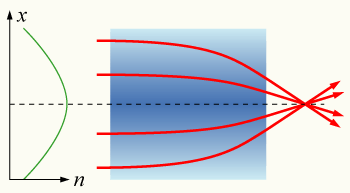Light hitting a GRIN (Gradient-index) lens at the optical angle
Physics Asked by Rob Weiss on January 9, 2021
In the image below, rays of light are hitting the GRIN (Gradient-index) lens at the optical angle and then converge towards the optical axis. Why do they do this? The refractive index is only a function of the distance from the optical axis and the rays of light are all parallel to that. Without a change in refractive index, the rays of light should not change direction (Snell’s law).

2 Answers
Light waves travel in a direction perpendicular to the wave front. When a plane wave is incident at the left-hand face of the GRIN lens in the diagram you provided, the speed of the wavefront propagation increases with radial distance from the axis of the lens. As a result, the wave front is deformed into a concave, spherical wavefront -- same as what happens with an ordinary lens. The spherical wavefront converges to a focus because it propagates in the perpendicular direction, toward the center of curvature of the wavefront.
Answered by S. McGrew on January 9, 2021
To get you started, consider that Maxwell’s equations are for the divergences and curls of the fields. These quantities are not strictly local in the sense that they are sensitive to what the fields are doing nearby, because they are derivatives in space. With this in mind, perhaps it is a little more intuitive why the rays might bend, even though they initially travel perpendicular to the gradient.
Answered by Gilbert on January 9, 2021
Add your own answers!
Ask a Question
Get help from others!
Recent Answers
- Joshua Engel on Why fry rice before boiling?
- haakon.io on Why fry rice before boiling?
- Jon Church on Why fry rice before boiling?
- Lex on Does Google Analytics track 404 page responses as valid page views?
- Peter Machado on Why fry rice before boiling?
Recent Questions
- How can I transform graph image into a tikzpicture LaTeX code?
- How Do I Get The Ifruit App Off Of Gta 5 / Grand Theft Auto 5
- Iv’e designed a space elevator using a series of lasers. do you know anybody i could submit the designs too that could manufacture the concept and put it to use
- Need help finding a book. Female OP protagonist, magic
- Why is the WWF pending games (“Your turn”) area replaced w/ a column of “Bonus & Reward”gift boxes?